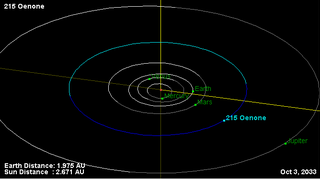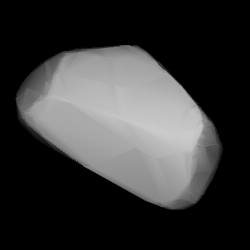
Lachesis is a large main-belt asteroid. It was discovered by French astronomer Alphonse Borrelly on April 10, 1872, and independently by German-American astronomer Christian Heinrich Friedrich Peters on April 11, 1872, then named after Lachesis, one of the Moirai, or Fates, in Greek mythology. A Lachesean occultation of a star occurred in 1999 and was confirmed visually by five observers and once photoelectrically, with the chords yielding an estimated elliptical cross-section of 184 × 144 km.

Dejanira is a main belt asteroid that was discovered by Alphonse Borrelly on 1 December 1875, and named after the warlike princess Deianira in Greek mythology. The Dejanira family of asteroids is named after it.

Iduna is a large main-belt asteroid that was discovered by German-American astronomer Christian Heinrich Friedrich Peters on October 14, 1877, in Clinton, New York. It is named after Sällskapet Idun, a club in Stockholm that hosted an astronomical conference; Idun is also a Norse goddess. A G-type asteroid, it has a composition similar to that of the largest main-belt asteroid, 1 Ceres.

191 Kolga is a large, dark main-belt asteroid that was discovered by German-American astronomer C. H. F. Peters on September 30, 1878, in Clinton, New York. It is named after Kólga, the daughter of Ægir in Norse mythology.

Ambrosia is a main belt asteroid that was discovered by the Corsican-born French astronomer J. Coggia on February 28, 1879, and named after Ambrosia, the food of the gods in Greek mythology.

Oenone is a typical main belt asteroid. It was discovered by the Russian astronomer Viktor Knorre on April 7, 1880, in Germany, and was the second of his four asteroid discoveries. The asteroid is named after Oenone, a nymph in Greek mythology.

Delia is a large Main belt asteroid. It was discovered by the French astronomer Auguste Charlois on 30 November 1894 in Nice. "Delia" is an epithet for the ancient Greco-Roman Moon goddess Artemis, for her birthplace at Delos. This asteroid is orbiting the Sun at a distance of 2.79 AU with an orbital eccentricity (ovalness) of 0.085 and a period of 4.64 yr. The orbital plane is tilted at an angle of 3.35° to the plane of the ecliptic.

402 Chloë is a large main-belt asteroid. It was discovered by French astronomer Auguste Charlois on 21 March 1895 from Nice. This asteroid is orbiting the Sun at a distance of 2.56 AU with a period of 4.09 years and an eccentricity of 0.11. The orbital plane is inclined at an angle of 11.8° to the plane of the ecliptic.

Iva is a main-belt asteroid orbiting the Sun, not to be confused with 1627 Ivar. It was discovered by American astronomer R. S. Dugan on 4 November 1902, and was named for Iva Shores, the young daughter of the family where he was staying in Heidelberg. This object is orbiting at a distance of 2.85 AU with a period of 4.82 yr and an eccentricity of 0.3. The orbital plane is inclined at an angle of 4.8° to the plane of the ecliptic.
Cheruskia is a minor planet, specifically an asteroid orbiting in the asteroid belt that was discovered by German astronomer Paul Götz on 26 July 1905 from Heidelberg.
618 Elfriede is a minor planet orbiting the Sun. On July 24, 2013, it occulted the magnitude 12.8 star 2UCAC 23949304, over parts of Mexico and southwestern United States.
718 Erida is a minor planet orbiting the Sun. It was discovered at Vienna on September 29, 1911, by Austrian astronomer Johann Palisa, and was named for Erida Leuschner, daughter of astronomer Armin Otto Leuschner. It is orbiting at a distance of 3.06 AU with a period of 5.34 yr and an eccentricity of 0.20. The orbital plane of this asteroid is inclined by an angle of 6.9° to the plane of the ecliptic.
780 Armenia is a minor planet in the asteroid belt orbiting the Sun. It is named after the Kingdom of Armenia, now Armenia. This object is orbiting at a distance of 3.11 AU with an eccentricity of 0.097 and a period of 5.50 yr. The orbital plane is inclined at an angle of 19.1° to the plane of rotation. This asteroid spans a girth of ~94 km. The long rotation period of this asteroid necessitated light curve data from more than one latitude. The overlapping data provided a solution with a period of 19.891±0.002 h and a brightness amplitude of 0.18±0.03 in magnitude.
820 Adriana, provisional designation 1916 ZB, is an exceptionally dark asteroid from the outer region of the asteroid belt, about 59 kilometers in diameter. It was discovered by German astronomer Max Wolf at Heidelberg Observatory in southern Germany, on 30 March 1916.
967 Helionape is an asteroid belonging to the Flora family of Main Belt asteroids. It was discovered by German astronomer Walter Baade at Hamburg Observatory on November 9, 1921, and was named after the Austrian theatrical actor Adolf von Sonnenthal. This object is orbiting the Sun at a distance of 2.23 AU with a period of 3.32 years and an eccentricity of 0.168. The orbital plane is inclined at an angle of 5.4° to the ecliptic.

1042 Amazone, provisional designation 1925 HA, is a dark asteroid and slow rotator in the outer asteroid belt, approximately 70 kilometers in diameter. It was discovered on 22 April 1925, by German astronomer Karl Reinmuth at Heidelberg Observatory in southern Germany. It is named after the Amazons from Greek mythology.
1818 Brahms, provisional designation 1939 PE, is an asteroid from the inner regions of the asteroid belt, approximately 6 kilometers in diameter. It was discovered on 15 August 1939, by German astronomer Karl Reinmuth at Heidelberg Observatory in southern Germany. The asteroid was named after composer Johannes Brahms.
2311 El Leoncito, provisional designation 1974 TA1, is a dark and reddish asteroid from the outer region of the asteroid belt, approximately 53 kilometers in diameter. The asteroid was discovered by astronomers at Félix Aguilar Observatory at the Leoncito Astronomical Complex in Argentina on 10 October 1974. It was later named after the discovering site.
39741 Komm, provisional designation 1997 AT6, is a stony asteroid and eccentric Mars-crosser from the innermost regions of the asteroid belt, approximately 2 kilometers in diameter. It was discovered on 9 January 1997, by American astronomer Roy Tucker at Goodricke-Pigott Observatory in Tucson, Arizona, United States. The asteroid was named for American helioseismologist Rudolf Komm.
1951 Lick, provisional designation 1949 OA, is a rare-type asteroid and Mars-crosser, approximately 5.6 kilometers in diameter. It was discovered on 26 July 1949, by American astronomer Carl Wirtanen at Lick Observatory on the summit of Mount Hamilton, California, and named for American philanthropist James Lick.










